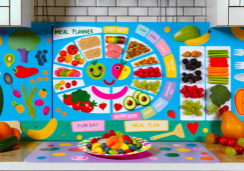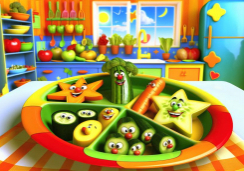Pleasing Picky Palates: Meal Planning Wins
Navigating the culinary minefield of picky eaters can feel like an impossible quest, yet with the right map, you'll find hidden treasures in the form of meal planning victories. You're aware that every individual has unique taste preferences, and you've likely seen the wrinkled noses at the dinner table more times than you care to count. Still, the art of meal planning offers a canvas upon which even the most selective palates can find satisfaction.
By introducing a variety of textures and flavors, and providing choices within structured limits, you can transform mealtime from a battleground to a negotiation table. The key lies in striking a balance between nutritional value and taste — a challenge that, if met with patience and creativity, can lead to a harmonious mealtime environment.
As you venture into the world of meal planning for the fussy eaters in your life, consider the subtle ways you can incorporate these tactics to ensure that everyone's plate is clean by the end of the evening, and stay tuned to uncover the secrets to making peace with the pickiest of palates.
Identifying Individual Tastes
To effectively accommodate the spectrum of individual tastes in meal planning, it's essential to understand how sensory sensitivities and personal experiences shape food preferences. Your child's reluctance to explore new foods may be rooted in sensory sensitivity, which can influence their reaction to different flavors and textures. If they're overwhelmed by strong smells or vibrant colors, it can lead to a preference for more familiar foods.
Understanding this can help you tailor meal planning and preparation to their comfort level. Offering a variety of options within their taste preferences encourages gradual exposure without overwhelming them. For instance, if they show a fondness for certain textures, you can introduce new foods that share similar qualities. This strategic approach can ease the anxiety associated with food neophobia, the fear of trying new foods.
Remember that picky eating can also be a sign of your child seeking control or autonomy. Positive reinforcement and involving them in meal preparation can foster a sense of ownership and might encourage your child to be more open to trying new foods. By recognizing these nuances, you can create a mealtime environment where your child feels supported to gradually expand their palate.
Incorporating Nutritious Substitutes
Understanding individual tastes not only aids in meal acceptance but also paves the way for introducing nutritious substitutes into your child's diet. Start with small portions of new foods alongside their favorites, making the experience less daunting. Gradually incorporate these healthy foods into familiar dishes; for example, blend leafy greens into a pasta sauce they love. This alternative cooking strategy can make a world of difference.
Make the process of introducing new foods a fun adventure. Organize taste tests, offering rewards and praise when they try nutritious options. It's not just about what's on the plate—how you present it can be just as important. Sneak in extra nutrition by pureeing colorful vegetables and adding them to soups or pancake batter. This way, you're enriching their meals without a battle at the dining table.
Always strive for a variety of foods, including a spectrum of whole grains, fruits and vegetables, and alternative protein sources. This diversity ensures they get a balanced diet and helps them develop a taste for nutritious options. Remember, patience is key when helping your child explore the world of healthy foods.
Structuring Mealtime Routines
Establishing consistent mealtime routines can anchor your child's day with structure and predictability, fostering a more positive relationship with food. Structuring mealtime routines involves setting regular meal and snack times, which helps establish a healthy eating pattern.
As you create a positive mealtime atmosphere, you're making mealtime an opportunity for your family to bond and for picky eaters to feel more at ease with trying new foods.
Involve your children in meal planning and preparation to build their interest and make mealtimes more enjoyable and stress-free. This inclusive approach can turn meal planning wins into an interactive family affair, reducing the stress associated with picky eating.
Aim for a mealtime atmosphere that's relaxed, avoiding pressuring your child to eat certain foods. Making mealtime a stress-free zone encourages children to explore tastes without anxiety, leading to a more varied diet over time.
Expanding Food Horizons
Gradually introducing new foods can significantly broaden picky eaters' palates, as sensory sensitivity often plays a role in their selective habits. When you're dealing with picky eaters, it's essential to acknowledge their fear of new foods, or food neophobia, and address it with patience.
To make healthy eating more appealing, start by incorporating new items into dishes that are already familiar to them. This approach makes trying new foods less intimidating and can make them more willing to try new flavors and textures.
Involve kids in meal planning and preparation to spark their interest in food. Offer a variety of options to choose from, which not only makes it fun but also teaches them about healthy eating habits. You can even turn it into a game where they taste-test and rate different foods, thereby expanding food horizons in an engaging way.
Engaging in Kitchen Activities
Building on the concept of expanding food horizons, involving picky eaters in kitchen activities can further increase their willingness to try new foods by fostering a sense of ownership and accomplishment. When you involve kids in meal planning and prep, they're more likely to be interested in the food they helped create. Encouraging children to eat new foods starts by making the process fun and interactive—let them pick recipes for picky eaters and help make the shopping list.
Involving kids in meal prep not only makes mealtime more enjoyable but also builds essential life skills. Start with small steps, such as washing vegetables or mixing ingredients. This gradually exposes them to new textures and flavors without the pressure of having to eat them. As they participate in meal preparation, they can taste test new items in a playful manner, making the experience less daunting.
Preparing meals in advance with your children is also a strategy for success. Use quality containers to store these meals, ensuring they're ready when you need them. Meal planning services like Prep Dish can simplify this process by providing tailored plans that are kid-friendly and nutritious. By engaging children in these activities, you're laying the groundwork for healthier eating habits and a willingness to try new foods.
Frequently Asked Questions
What Are the 5 P's of Picky Eating?
You're tackling picky eating with the 5 P's: Picky Strategies, Taste Exploration, Texture Acceptance, Fun Foods, and Variety Tricks. Sensory Play, Presentation Matters, Positive Reinforcement, Flavor Pairing, and Hunger Games are key to your success.
What Is the Best Diet for Picky Eaters?
The best diet for you includes taste trials, texture variations, and comfort foods with ingredient swaps. Try creative presentation, flavor balancing, hidden vegetables, and allergy accommodations, along with cultural dishes and varied snack options.
What Are the 5 Rules in Planning Meals?
You should prioritize balance variety, consider dietary restrictions, select seasonal items, focus on nutrient density, respect cultural preferences, pair flavors smartly, account for food texture, schedule meal timing wisely, control portions, and use ingredient substitutions.
What Are 3 Tips for Picky Eaters?
You should start with small portions, introduce taste exploration and texture variation, and balance flavors. Offer fun presentation, hidden vegetables in meals, and provide dip options to make eating more interactive and enjoyable.
Conclusion
You've got this! By recognizing individual tastes, you're tailoring meals that satisfy. Nutritious substitutes keep them healthy without a fuss.
A consistent mealtime routine offers comfort, while gently expanding their food horizons broadens tastes. And, getting hands-on in the kitchen? It turns meal prep into fun, educational bonding.
Stick to these strategies, and you'll transform picky eating into adventurous dining, ensuring your meal plans are always a hit. Keep it up, and watch those picky palates bloom!










